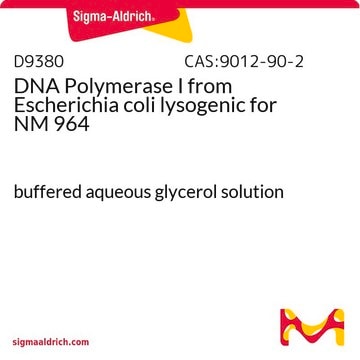11745808910
Roche
Nick Translation Mix
sufficient for 50 labeling reactions, pkg of 200 μL, solution
Synonyme(s) :
nick translation
About This Item
Produits recommandés
Forme
solution
Niveau de qualité
Utilisation
sufficient for 50 labeling reactions
Conditionnement
pkg of 200 μL
Fabricant/nom de marque
Roche
Technique(s)
nucleic acid labeling: suitable
Couleur
colorless
pH
~7.5 (68 °F)
Solubilité
water: miscible
Adéquation
suitable for fluorescent labeling techniques
suitable for molecular biology
Application(s)
genomic analysis
life science and biopharma
Température de stockage
−20°C
Catégories apparentées
Description générale
Individual templates produce consistent results in the standard 90-minutes reaction, and result in an average probe length of 200 base pairs up to 500 base pairs.
Assay Time: 100 minutes
Sample Materials
- Supercoiled and linearized plasmid DNA
- Supercoiled and linearized cosmid DNA
- Purified PCR products
Spécificité
Application
The Nick Translation Mix is designed for direct fluorophore-labeling of in situ probes. Fluorescein-12-dUTP and Tetramethyl-Rhodamine-5-dUTP from Roche Applied Science or other commercially available fluorophor-labeled nucleotides can be combined with the Nick Translation Mix. Direct fluorophore-labeled in situ probes are used for the detection of multi copy or very large hybridization targets on metaphase chromsomes or interphase nuclei.
For a standard labeling reaction using 1 μg template in 20 μl total reaction volume, 4 μl of 5x concentrated fluorophore labeling mix are required.
Composants
1 vial with 5x concentrated solution, stabilized reaction buffer in 50% glycerol (v/v), DNA Polymerase I and DNase I.
Qualité
Principe
E. coli DNA Polymerase I synthesizes DNA complementary to the intact strand in a 5′?3′ direction using the 3′-OH termini of the nick as a primer. The 5′?3′ exonucleolytic activity of DNA polymerase I simultaneously removes nucleotides in the direction of synthesis. The polymerase activity sequentially replaces the removed nucleotides with isotope-labeled or hapten-labeled deoxyribonucleoside triphosphates. At low temperature (+15°C), the unlabeled DNA in the reaction is thus replaced by newly synthesized labeled DNA.
Stockage et stabilité
Autres remarques
Denaturing of the template before nick translation is not required.
Code de la classe de stockage
12 - Non Combustible Liquids
Classe de danger pour l'eau (WGK)
WGK 1
Point d'éclair (°F)
does not flash
Point d'éclair (°C)
does not flash
Certificats d'analyse (COA)
Recherchez un Certificats d'analyse (COA) en saisissant le numéro de lot du produit. Les numéros de lot figurent sur l'étiquette du produit après les mots "Lot" ou "Batch".
Déjà en possession de ce produit ?
Retrouvez la documentation relative aux produits que vous avez récemment achetés dans la Bibliothèque de documents.
Les clients ont également consulté
Notre équipe de scientifiques dispose d'une expérience dans tous les secteurs de la recherche, notamment en sciences de la vie, science des matériaux, synthèse chimique, chromatographie, analyse et dans de nombreux autres domaines..
Contacter notre Service technique







